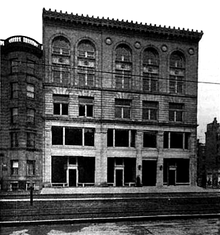Josephine Wright Chapman

Josephine Wright Chapman (1867–1943) was an American architect in Boston, Massachusetts, and New York. Chapman received no formal education or encouragement from her family to pursue architecture. She is considered one of the most important female architects around the start of the 20th century.[1]
Chapman was raised in Fitchburg, Massachusetts. She would leave home and pawn jewelry and clothing to support herself. In 1892, she was able to convince Clarence Blackall to let her apprentice under him. Through Blackall she learned about public building design and how to experiment with new materials. In 1893, the firm designed the first steel-frame building, the Carter Building in Boston. Chapman would go on to set up her own firm in Boston, in Grundmann Studios, a women's art collective, in 1897.[2] Upon forming her firm, Chapman was commissioned by Harvard University to design their Craigie Arms dormitory. While working on that project she also designed St. Mark's Episcopal in Fitchburg, Massachusetts. By the start of the 20th century, Chapman had six drafters, including one woman, at her firm.[1]
After 1901, she applied to join the American Institute of Architects and the Boston Architectural Club. Both refused to admit her. In 1907 she was accepted by the New York Society of Architects, after relocating to New York City.[3] There, she opened a firm at Washington Square Park, focusing on residential design.[1] Around 1909 she "reign[ed] supreme as the only woman architect in the Hub."[4]
Designs


- Craigie Hall / Craigie Arms, Harvard University, Cambridge, Massachusetts (1897)[5]
- All Saints Episcopal church, Attleboro, Mass. (c. 1900)[6]
- Episcopal church, Leominster, Mass. (c. 1900)[7]
- New England Building, Pan-American Exposition, Buffalo, New York, 1901[8]
- Worcester Woman's Club / Tuckerman Hall, Worcester, Mass. (1902)[9]
- New Century Building, Huntington Ave., Boston (c. 1903)[10][11]
- Hillandale, Georgetown, Washington DC (1922)[12]
- Houses, Douglas Manor, Queens, NY (c. 1916)[13][14]
See also
References
- ^ a b c Sarah Allaback (May 23, 2008). The first American women architects. University of Illinois Press. p. 60. ISBN 978-0-252-03321-6. Retrieved February 5, 2012.
- ^ Boston Evening Transcript – October 23, 1897
- ^ She plans fine houses. Ottawa Free Trader, April 19, 1901
- ^ Some Successful Women Architects. Wilkes-Barre Times-Leader (Pennsylvania); Date: Jan 20, 1909
- ^ Ottawa Free Trader, April 19, 1901
- ^ She Builds Churches. Boston Has Developed a New Sphere of Industry for Women's Effort. Biloxi Daily Herald; Date: Jun 22, 1900
- ^ Biloxi Daily Herald; Date: Jun 22, 1900
- ^ Carpentry and Building, April 1901
- ^ "Tuckerman Hall".
- ^ Helen M. Winslow. The Boston Women's Club House. Delineator, 1903.
- ^ Woman's Club House Corporation. Boston Evening Transcript – October 23, 1897
- ^ "Hillandale Homeowners Association".
- ^ Habitats/Douglas Manor; Rustic Queens Hideaway. The New York Times, August 14, 1994
- ^ "Douglas Manor, NY". Archived from the original on January 8, 2013. Retrieved October 20, 2012.
Further reading
- Chapman. How to Decorate Your Home. Success. June 1904.
- Chapman. Pretty Wall Coverings. Success. May 1905.
- Chapman. Home Furnishings and Decorations. Success, June 1905.
- Chapman. Letter to the editor. New York Times, September 8, 1914.
- Sarah Allaback. The First American Women Architects. University of Illinois Press, 2008.
External links
- WorldCat. Chapman, Josephine Wright
- Google news archive. Articles about Chapman
- Flickr. Tuckerman Hall, Worcester, 2008
- Flickr. Tuckerman Hall, Worcester
- Pan-American Exposition of 1901, Buffalo NY.
